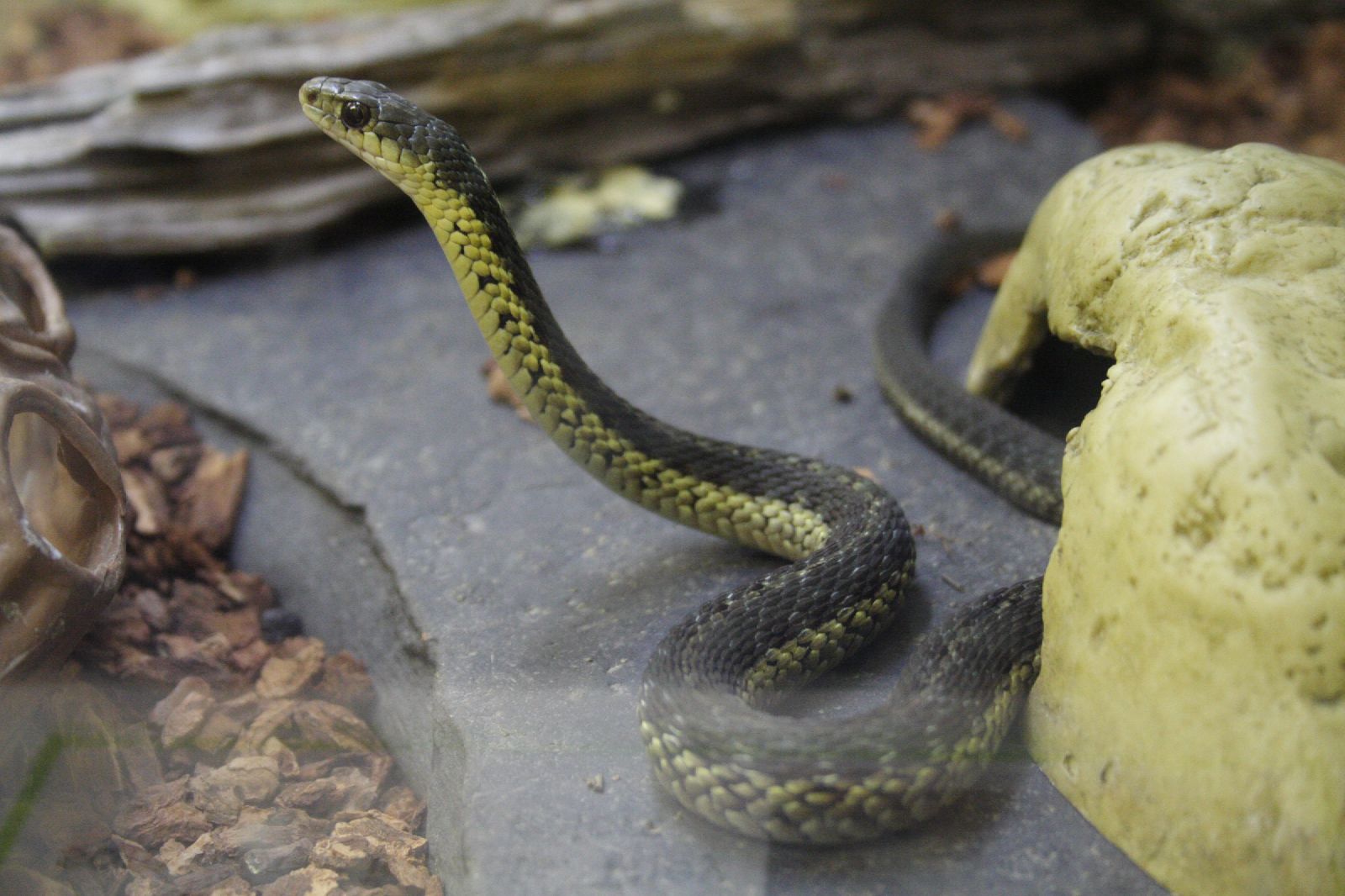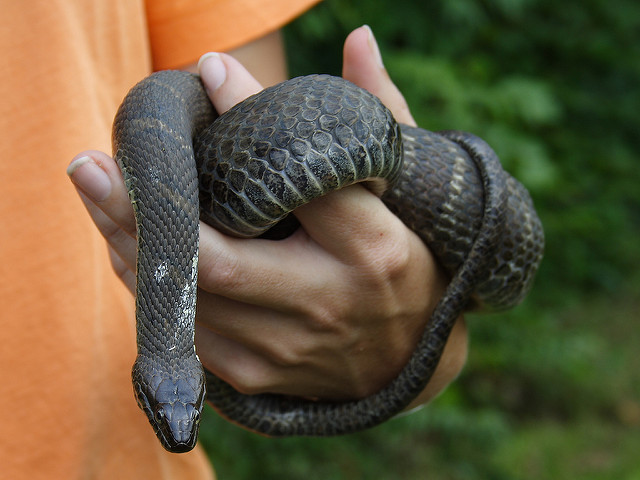We have all been there before, walking in a garden or along a pond edge, when all of a sudden a snake slithers out onto the path. Snakes, especially bigger ones, can look intimidating. Around here, though, almost all the snakes are totally harmless to humans. The two most common types of snake that you might encounter when out for a hike are garter snakes and the Northern Water Snake.
Garter snakes are actually helpful to humans, they eat things like rodents that can harm humans, and leeches if they live near water. There are two types of garter snakes found in this area, the common garter snake, and the short-headed garter snake. The common garter snake is the most common snake in the area, and lives in lawns, fields, and the edges of woodlands. They can be up to two feet long, with a diet consisting of insects, slugs, worms and the occasional small frog or mouse if they get lucky. The short-headed garter snake reaches an adult size of 3-4 feet, and has a smaller head than other garter snakes. It is usually light gray or brown color with a light green or yellow stripe running down the center of its back, this snake is usually very docile, and eats mostly worms, and sometimes small fish or amphibians.

Audubon’s Animal Ambassador, Garter Snake. Visit the Nature Center to see Garter and California King Snake.
The most common misconception regarding snakes native to this area is that we have Cottonmouths, also known as water moccasins. They are actually Northern Water Snakes, which are nonvenomous. They do look very similar, and the water snakes sometimes act quite aggressive, but Cottonmouths are found in the Southern portion of the United States, not New York or Pennsylvania.
Many people falsely assume that there are venomous snakes here, which there are, but you really have to go looking for them. The only venomous species native to this area is the Timber Rattlesnake, which is now rarely found here, as it prefers hard to reach areas of dense forests and rocky hillsides. It is a protected species in many areas. The Timber Rattlesnake is easily avoidable due to its habit of rattling when it senses danger. Most danger is eliminated by not interfering with the snake if you do happen to find one. The vast majority of snakebites, venomous as well as nonvenomous, occur when a person attempts to handle a snake. When left alone, the Timber Rattlesnake is an impressive thing to witness. In the case where a snake must absolutely be moved, like when it is in the road or is presenting a danger to children, it is best to call a professional.

A native Northern Water Snake, which is nonvenomous. This species is often misidentified as the venomous Cottonmouth, which is not native to New York or Pennsylvania. They can be aggressive if aggravated, but are a vital part of the ecosystem.
Snakes actually do a massive amount of good for humans in a way that you might not expect: fighting Lyme disease. A common food source for many snakes is rodents, which are host to the species of tick that carries Lyme disease. Theoretically, snakes eat the rodents that carry the ticks, and in turn, the number of ticks carrying Lyme disease will fall because they do not have their hosts. Without snakes, there might be a rise in the number of rodents, and while not all rodents will carry ticks that spread Lyme disease, a rise in the rodent population could harm the ecosystem and humans in other ways. Damage to property and the spread of other diseases and parasites, especially to pets, are two main ways. Removing any animal from an ecosystem causes an imbalance in that ecosystem, and in the case of the snake, removing it would cause human habitat to be completely overrun with rodents carrying diseases and causing damage.
I get just as excited seeing a snake on a hike as I would a mother deer and her fawn. Seeing these animals elicits a feeling of joy, because seeing any animal should be seen as a learning experience, and watching a snake in a field or on a sidewalk is fascinating. Talk about it with the people you are with, take some pictures, and then watch the snake go on its way. Harming snakes just because they are snakes is something that needs to stop, because it disrupts the balance of the ecosystem in ways that can’t be repaired overnight. If you are worried about a snake harming you or your family, call a professional, a local nature center, or do a bit of research. Leave the snake be, and you will be just fine, they are a wonderful creature to watch, and they play an important role in the ecosystem.
Audubon Community Nature Center builds and nurtures connections between people and nature. View snakes and other wildlife in the Nature Center or along the trails. The Nature Center is open daily from 10 a.m. until 4:30 p.m. except Sundays when it opens at 1 p.m. The trails are open from dawn to dusk. ACNC is located at 1600 Riverside Road, just east of Route 62 between Warren and Jamestown. Online you can find more information at auduboncnc.org or by calling (716) 569-2345.
Adam Carlson is a Summer Nature Education intern at ACNC.


Recent Comments